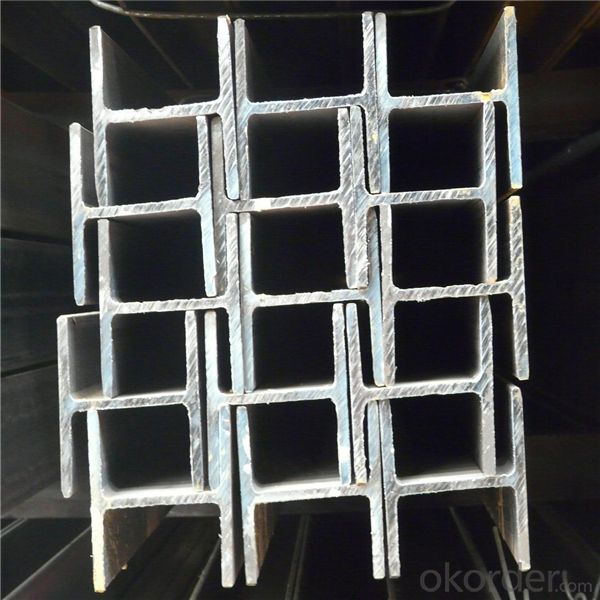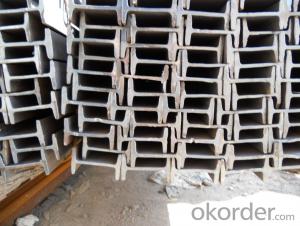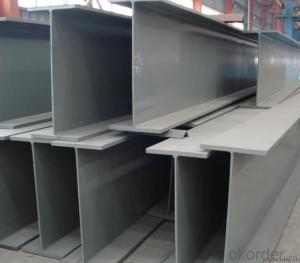European Standard Structural H Steel Beams Price per Kg
- Loading Port:
- Hai Kou
- Payment Terms:
- TT OR LC
- Min Order Qty:
- 100 m.t
- Supply Capability:
- 150000 m.t/month
OKorder Service Pledge
OKorder Financial Service
You Might Also Like
Item specifice
Quick Detail
OKorder is offering H BEAM at great prices with worldwide shipping. Our supplier is a world-class manufacturer of steel, with our products utilized the world over. OKorder annually supplies products to African, South American and Asian markets. We provide quotations within 24 hours of receiving an inquiry and guarantee competitive prices.
Standard: | ASTM, GB, JIS | Grade: | Q235Q345ss400ss490 | Dimensions: | HM100*100*6*--8#428*407*20*35 |
Place of Origin: | Hebei, China (Mainland) | Brand Name: | JINXI | Type: | Alloy Structural Steel |
Application: | roof beam | Shape: | Beams | price: | competitive |
We can provide qualify goods,competitive price and speedy delivery.

Products Description
Description | High Frenquency Thin-walled H Beam | |
Product Name | H Beam | |
Specification | Height:75-500mm Width:50-250mm | |
Standard | GB700-1998,GB/T1591-1994 | |
Material | Q235B,Q345B | |
Application | a. Bridge and post structures in industry and civil use of steel construction. | |
Certificates | ISO,SGS,BV,TUV,Lloyd | |
MOQ | 20 tons or according to customers’ requirement. | |
Port of Delivery | Tianjin Port of China | |
Remarks | We can provide qualify goods,competitive price and speedy delivery |
Packaging & Delivery
Packaging Details: | Packed with waterproof paper and steel banding. |
Delivery Detail: | 15-25 |
FAQ
1. How can I get some samples?
We are honored to offer you samples. New clients are expected to pay for the courier cost. The samples are free for you.
2 Do you have any certificates?
Our products passed inspection of SGS, FDA, and CE Quality is priority! Every worker keeps the QC from the very beginning to the very end, Quality control department especially responsible for quality checking in each process.
3 Can your factory print or emboss my logo on the goods?
Yes, we can print or emboss the logo on the goods or their packing box.
4 What information should I let you know if I want to get a quotation?
1) The specification of products (length x width x thickness);
2) The temper and alloy.
3) The final product you will use to be made
4 It will be better if you can show us the pictures or design sketch. Samples will be best for clarifying. If not, we will recommend relevant products with details for reference.We usually produce goods based on customers
Samples or based on customers’ picture, logo, sizes etc.
- Q:What are the considerations for selecting the appropriate fabrication method for steel H-beams?
- There are several factors to consider when choosing the right fabrication method for steel H-beams. These factors include the required dimensions, quality requirements, cost-effectiveness, and production volume. To begin with, the dimensions of the H-beam are crucial in determining the fabrication method. Different methods, such as hot rolling, cold bending, or welding, have their own limitations in terms of size and shape. It is important to ensure that the chosen fabrication method can meet the desired dimensions of the H-beam. Furthermore, the quality requirements of the H-beams should be carefully evaluated. This includes factors like strength, durability, and surface finish. Each fabrication method has its own impact on the final product's quality. For example, hot rolling is known for producing H-beams with superior strength and surface finish compared to cold bending. However, welding may introduce potential defects that can affect overall quality. Cost-effectiveness is another important consideration. Different fabrication methods have varying costs associated with them, including material, labor, and equipment expenses. The appropriate method should strike a balance between desired quality and fabrication costs. Lastly, the production volume also influences the choice of fabrication method. High-volume production often favors methods like hot rolling or welding, which offer higher efficiency and faster production rates. On the other hand, low-volume production allows for more flexibility in choosing methods that require more manual labor, such as cold bending. In conclusion, when selecting the right fabrication method for steel H-beams, it is important to consider dimensions, quality requirements, cost-effectiveness, and production volume. Finding a balance between these factors ensures the desired outcome in terms of both quality and cost.
- Q:How do steel H-beams compare to other structural beams, such as I-beams or W-beams?
- Wide flange beams, also referred to as Steel H-beams, offer numerous benefits when compared to other structural beams like I-beams or W-beams. One primary advantage lies in their impressive strength-to-weight ratio. H-beams are constructed to handle heavy loads while remaining relatively lightweight, making them ideal for a wide array of applications. In contrast to I-beams, H-beams possess wider flanges and thinner webs, resulting in a more even distribution of the load. This particular design characteristic enables H-beams to support heavier loads and provide enhanced stability. Furthermore, the wider flanges provide increased resistance against bending and twisting forces, rendering H-beams more rigid and less susceptible to deformations. Another advantage of H-beams over W-beams is their versatility and adaptability. H-beams can be easily modified, cut, and welded to suit specific project requirements. This flexibility allows for greater customization and cost-effectiveness, as it reduces the need for additional fabrication or complex connections. Additionally, H-beams offer superior lateral stability when compared to W-beams. The wider flanges of H-beams facilitate the efficient distribution of lateral loads, such as wind or seismic forces, thereby minimizing the risk of structural failure. Consequently, H-beams are often the preferred choice in regions prone to high winds or seismic activity. Nevertheless, it is important to acknowledge that the selection between steel H-beams, I-beams, or W-beams depends on the specific application and project requirements. Each beam type possesses its own unique advantages and limitations, underscoring the significance of consulting with a structural engineer or expert to determine the most suitable beam for a particular project.
- Q:Are Steel H-Beams resistant to warping or bowing over time?
- Steel H-Beams exhibit exceptional resistance against warping or bowing as time passes. This remarkable durability stems from their structural design and the inherent qualities of steel. H-Beams undergo manufacturing processes that result in a high strength-to-weight ratio, enabling them to bear hefty loads while retaining their form for extended durations. Furthermore, steel boasts outstanding dimensional stability, making it less susceptible to expansion or contraction caused by temperature or moisture fluctuations in comparison to alternative materials. These remarkable attributes establish Steel H-Beams as a dependable option for construction endeavors that prioritize long-term stability.
- Q:What is the weight of a steel H-beam?
- The weight of a steel H-beam can vary depending on its dimensions, length, and the specific type of steel used.
- Q:What are the limitations of steel H-beams?
- There are several limitations to steel H-beams. Firstly, their weight can be a significant drawback, making them difficult to handle and transport. Additionally, steel H-beams may not be suitable for certain applications where lightweight materials are required. Moreover, steel H-beams are prone to corrosion, especially in humid or corrosive environments, which can weaken their structural integrity over time. This necessitates regular maintenance and protective coatings to prevent deterioration. Another limitation is their limited flexibility in terms of design and shape. Steel H-beams are typically available in standard sizes and configurations, which may not always meet specific project requirements. Customization options can be limited and expensive. Finally, steel H-beams can be costlier compared to alternative materials, especially for smaller-scale projects. The high production and transportation costs associated with steel can make it less economical. Overall, while steel H-beams possess numerous advantages, it is crucial to consider these limitations to determine their suitability for a particular construction project.
- Q:Can steel H-beams be used in sports stadium construction?
- Yes, steel H-beams can be used in sports stadium construction. Steel H-beams are commonly used as structural elements in construction due to their strength, durability, and load-bearing capabilities. They provide excellent support for large spans and heavy loads, making them suitable for constructing the grandstands, roofs, and other structural components of sports stadiums. The H-shape of the beams allows for efficient distribution of weight and provides stability, ensuring the safety of the stadium structure. Moreover, steel beams can be fabricated to custom sizes and lengths, making them versatile and adaptable to the specific requirements of each stadium project. Overall, steel H-beams are a popular choice in sports stadium construction due to their strength, versatility, and ability to withstand the demanding loads and conditions associated with such structures.
- Q:Are steel H-beams resistant to seismic activity?
- Steel H-beams are generally known to be resistant to seismic activity. This is because steel is a highly durable and strong material, making it ideal for withstanding the forces generated during seismic events. H-beams are specifically designed to evenly distribute the load along their length, offering excellent structural support against vertical and lateral movements. Furthermore, steel H-beams are commonly used in earthquake-prone regions due to their superior ability to withstand seismic forces. The flexibility and elasticity of steel allow it to absorb and dissipate seismic energy, minimizing damage caused by ground shaking. Additionally, steel H-beams are often interconnected with other structural elements, such as columns and braces, forming a seismic-resistant system that effectively absorbs and redirects seismic forces. It is important to note, however, that the seismic resistance of steel H-beams can vary depending on factors such as design, construction quality, and adherence to building codes and regulations. To ensure that steel H-beams are appropriately designed and installed to withstand the specific seismic conditions of an area, proper engineering and construction practices must be followed. In conclusion, when designed and constructed properly, steel H-beams provide excellent resistance to seismic activity and are widely utilized in earthquake-resistant building structures.
- Q:Can steel H-beams be used for vehicle ramps or bridges?
- Yes, steel H-beams can be used for vehicle ramps or bridges. They are commonly used in construction projects due to their high strength and load-bearing capacity. The H-beams provide structural support and stability, making them suitable for creating stable and durable ramps or bridges for vehicles.
- Q:Can steel H-beams be used in cold storage facilities?
- Indeed, cold storage facilities can utilize steel H-beams. These beams are frequently employed in construction due to their robustness and endurance, rendering them well-suited for a multitude of purposes, including cold storage facilities. The distinctive H shape of these beams grants them exceptional load-bearing capabilities, enabling them to bear substantial burdens such as insulation panels and refrigeration equipment. Furthermore, steel exhibits remarkable resistance to temperature fluctuations and can endure the frigid temperatures commonly encountered in cold storage facilities without compromising its structural integrity. Consequently, steel H-beams present a fitting option for construction within cold storage facilities.
- Q:Can steel H-beams be used for office buildings or commercial complexes?
- Yes, steel H-beams can be used for office buildings or commercial complexes. Steel H-beams are commonly used in construction due to their high strength and durability. They provide structural support and can withstand heavy loads, making them suitable for larger and taller buildings such as office complexes or commercial structures. Additionally, steel H-beams offer versatility in design and can be easily assembled, making them a popular choice in modern construction projects.
1. Manufacturer Overview |
|
|---|---|
| Location | |
| Year Established | |
| Annual Output Value | |
| Main Markets | |
| Company Certifications | |
2. Manufacturer Certificates |
|
|---|---|
| a) Certification Name | |
| Range | |
| Reference | |
| Validity Period | |
3. Manufacturer Capability |
|
|---|---|
| a)Trade Capacity | |
| Nearest Port | |
| Export Percentage | |
| No.of Employees in Trade Department | |
| Language Spoken: | |
| b)Factory Information | |
| Factory Size: | |
| No. of Production Lines | |
| Contract Manufacturing | |
| Product Price Range | |
Send your message to us
European Standard Structural H Steel Beams Price per Kg
- Loading Port:
- Hai Kou
- Payment Terms:
- TT OR LC
- Min Order Qty:
- 100 m.t
- Supply Capability:
- 150000 m.t/month
OKorder Service Pledge
OKorder Financial Service
Similar products
New products
Hot products
Hot Searches
Related keywords



























